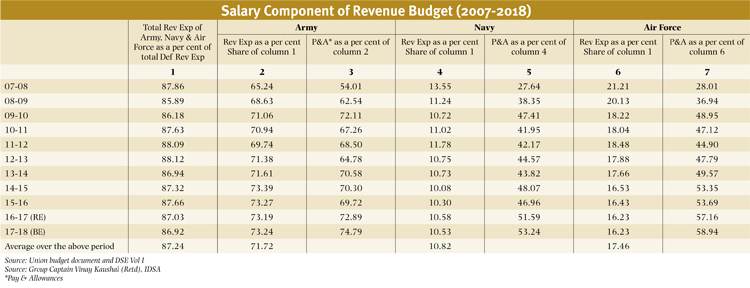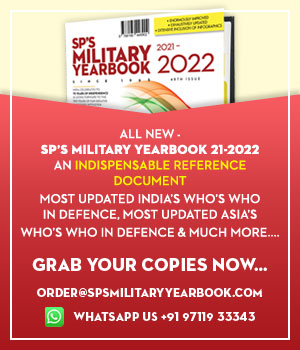INDIAN ARMED FORCES CHIEFS ON OUR RELENTLESS AND FOCUSED PUBLISHING EFFORTS

The insightful articles, inspiring narrations and analytical perspectives presented by the Editorial Team, establish an alluring connect with the reader. My compliments and best wishes to SP Guide Publications.

"Over the past 60 years, the growth of SP Guide Publications has mirrored the rising stature of Indian Navy. Its well-researched and informative magazines on Defence and Aerospace sector have served to shape an educated opinion of our military personnel, policy makers and the public alike. I wish SP's Publication team continued success, fair winds and following seas in all future endeavour!"

Since, its inception in 1964, SP Guide Publications has consistently demonstrated commitment to high-quality journalism in the aerospace and defence sectors, earning a well-deserved reputation as Asia's largest media house in this domain. I wish SP Guide Publications continued success in its pursuit of excellence.
- Indian Armed Forces gets the first Woman Director General of Medical Service (Army)
- General Upendra Dwivedi takes over as the Chief of the Army Staff
- Rajnath Singh assumes charge as Defence Minister for the second consecutive term
- Prime Minister witnesses 'Bharat Shakti' – a Tri-Services Firing and Manoeuvre Exercise in Pokhran, Rajasthan
- Interim Defence Budget 2024-25 — An Analysis
- Union Defence budget 2024
Defence Budget: Assured Allocations to Achieve the Goals
Delays in replacing the legacy weapons system with the more modern systems have hampered the operational readiness of armed forces. It is time to look for measures to mitigate the shortfall.

Indian defence is in need of substantial investment to replace its legacy systems, which are facing obsolescence. Most of the systems can’t be further upgraded, and thus require replacement with more modern systems to confront rapidly modernising adversaries like China. In last few years, number of acquisition programmes that have been postponed or cancelled thus adversely affecting the modernisation of the armed forces. In addition, many programmes are running years behind their schedule, leading to substantial cost escalation. This has a negative impact on modernisation and availability of funds for other programmes. It would not be out of place to mention that in any future conflict, India would be using three to four decades old weapon systems. This is a disturbing scenario for our armed forces.
Budget Trend
As the data suggests (see tables), the availability of money for capital acquisition, in real terms, has shrunk. The modernisation budget during the 2007-17 shows that in 2007 the modernisation budget was $7.5 billion which became $10.75 billion in 2017-18. This was not enough even to mitigate the inflation over a ten year period. Defence inflation is always higher than the general inflation. Unlike equipment, ammunition is procured from the revenue budget and the critical shortages reported in the media from time to time are due partly to reduction in the budget for “stores”. In last ten years, the percentage of pay and allowance in the revenue budget of Army, the most manpower intensive service, has increased from 54 per cent in 2007-08 to 75 per cent in 2017. Similarly the other two services have also seen their pay and allowances increasing from nearly 30 per cent to over 50 per cent of their allocations. This obviously has an effect on the other heads under the Revenue Budget.
Defence expenditure as a percentage of central government expenditure, in last decade, has remained unchanged and hovers around 12 per cent. But in terms of per cent of GDP, from 2009-10 when it peaked to 2.1 per cent, it has seen a downward trend and was 1.5 per cent in last financial year. In the current financial year, 2.95 lakh crore have been earmarked for defence which accounts for 12.10 per cent of the government expenditure and is around the lowest figure as a ratio to overall government expenditure since 1950. One third of the total allocation approximately has been earmarked for the capital expenditure of the Ministry of Defence (MoD). The Capital allocation for Ministry of Defence under BE 2018-19 is 33.1 per cent of the total Central Government Expenditure on Capital Account, which is 3,00,441 crore.
The total allocation for defence for 2018-19 represents a growth of 7.8 per cent if BE figures are taken and 5.9 per cent if RE figures are taken. It is not enough to even cater for the likely inflation.
Thus bearing in mind the requirement of the Services and the economic woes of the country, it would be advisable to hold a holistic review of the defence budget to decide on the future course of action. The respective strengths and weaknesses of each service should be taken into account to decide upon the capabilities required and focal areas of expenditure of the overall Capital budget allocated to the three Services and priorities should be fixed accordingly.
Threat Scenario
India is likely to face four types of threats and challenges in the future including traditional threats from China and Pakistan; contemporary threats in the form of terrorism; internal challenges; and out of area contingencies. This implies that India faces a two front threat as far as conventional conflicts are concerned and these may be large scale conflicts or even border wars under the nuclear shadow. The other challenges are in the form of international terrorism, home grown terrorism and insurgencies aided and abetted by some of our neighbours, and the out of area challenges whose contours are hazy at present. This is what is referred as the two and a half front war.
Most analysts feel that conventional conflicts in the present circumstances when the region has become nuclearised are unlikely, however Kargil type border wars cannot be precluded, considering that we have unresolved borders in the form of 740 km of Line of Control (LoC and 110 km of AGPL) with Pakistan and 4052 km of Line of Actual Control (LAC), unresolved border, with China. The fact is that there is no assurance that the border wars will not escalate into larger conflicts involving more than one sector. This creates an uncertainty in operational planning, in force levels required and in capability enhancement because confronting two adversaries simultaneously on two widely separated fronts is a daunting challenge which has a direct impact on the above issues and our budgets have to be aligned accordingly. Thus we could state that should there be another war it will be of ‘Hybrid’ nature and it may involve fighting two enemies simultaneously on two widely separted fronts, in varying terrain, at the borders, while simultaneously countering terrorism and/or insurgency in the hinterland.
This two and a half front ‘Hybrid’ war will require the internal security apparatus, including the central armed police, intelligence agencies of centre and state and also the technical institutions safe guarding our cyber and communication networks to operate closely and in an integrated fashion. This coordination at the national level has never been practiced.
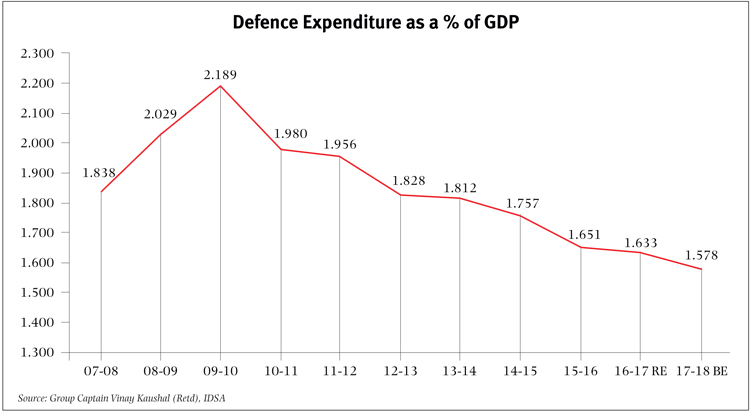
Doklam like situations are likely to arise in the eastern theatre along the LAC where China’s strategy seems to be to claim and nibble away territory to acquire tactical/strategic advantage in various sectors. Doklam is only a manifestation of this strategy. Thus we will have to keep such situations in mind against a rapidly modernising adversary with a larger force in the North and East with a capability to muster larger forces at short notice in the future. His infrastructure developments point towards such capabilities.
In the Western sector, we are witnessing increase in the cross border firing both on the international border and along the Line of Control in Jammu and Kashmir. This could be a prelude to some adventurism on part of Pakistan if they come to the conclusion that we are indecisive politically and weak militarily as was the case during Kargil. The fact that Pakistan is closely supported by China makes us more vulnerable unless we prepare for this scenario.
The time has come for the government to seriously consider the transformation of the Indian military for the future, through technological improvements coupled with new joint operational doctrines and innovative Operational Art along with joint operational training. This is vital for ensuring overall economy, and judicious expenditure of Defence Budget to preserve India’s sovereignty and furthering its national interests.
Following the establishment of the Modi Government with the strongest mandate ever, a lot was expected by the armed forces regarding the hastening of the modernisation process. However, the expected change has so far not manifested itself on the ground and the army is the worst off as far as the modernisation is concerned because it needs replacements for nearly every weapon and equipment that it currently has in its inventory starting with assault rifles and carbines to heavier infantry weapons such as light and medium machine guns, sniper rifles, anti material rifles, antitank guided missiles, long range artillery and air defence weapons, including night fighting equipment, surveillance devices, and a new helicopter fleet comprising various categories of helicopters, just to name a few.
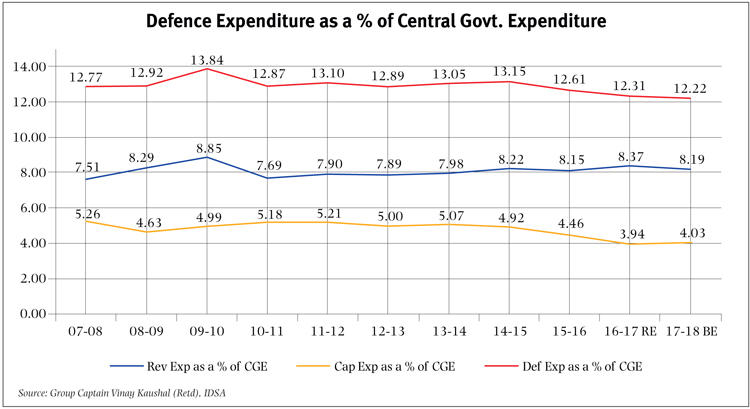
In last one decade, because of the implementation of the 7th Pay Commission and One Rank One Pension, the salary component in the three services revenue budget has increased as is the case in all departments of the government. This has caused an overall distortion of revenue to capital budget and thus a short fall in Capital Budget for modernisation and procurement. The expenditure on maintenance of the current force levels including procurement of ammunition which is bought from the revenue budget is also impacted. This shortage is well known and until more allocation is made the situation is not going to improve and will continue to affect operational readiness of the Services especially the army which is a manpower oriented force. Our procurement procedures despite DPP 2016 continue to be cumbersome. Thus no worthwhile upgrade of weapons and equipment has taken place in the last two decades or more.
As regards to ‘Make in India’, the Government has notified the strategic partnership policy (SPP) focusing on selecting an Indian strategic partner for all major defence procurements by the Government in key segments like helicopters, submarines, armoured fighting vehicles etc. This policy is an integral step towards indigenization and capability development. It would not be an exaggeration to say that, if properly implemented, the policy may result in revolutionary changes in domestic defence production and the creation of an ecosystem for defence manufacturing. However, the progress on the ground is excruciatingly slow.
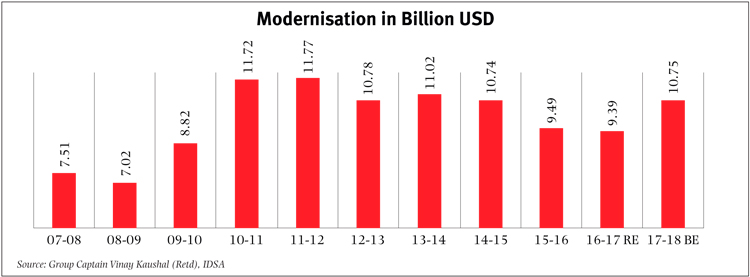
Way Forward
In last two decades, Indian Army has raised a few new divisions of infantry and artillery using the war wastage reserves. Now, it is imperative for the government to not only replenish the war wastage reserves but also to cater for the long delayed modernisation. At present, Army is equipped with legacy systems in all branches of the Army and there is an urgent need for replacement of all its these systems. In last one year, Army has procured a large quantity of various category of ammunition to increase its reserves to the levels required for future conflicts. However the modernisation of Army requires a consistent and an ongoing modernization plan spread well over the next 15 years with assured allocations in the Capital budget of the Army to overcome the current situation. This needs to be addressed at the earliest if we are serious about the long delayed modernisation of the Army.
Our recommendations are:
- Assured allocations to the Army (as indeed the other two Services as well) to fulfill its modernisation commitments as per the Long Term Plan drawn up by the Army , coordinated by the Integrated Defence Staff and approved by Government.
- Carry over the unspent portions of the Capital Budget so as to ensure that the requirements of the annual acquisition plan (AAP) which is a subset of the five years Services Capital Acquisition Plan (SCA P) which in turn is a part of the 15 year Long Term Integrated Perspective Plan (LTIPP) which covers three SCA Ps of five years each, is achieved and budgetary support is not an obstacle to achieve the modernisation goals set forth in the plan.
- Officers connected to a modernisation projects are, technically qualified or are from technological background, and are given viable tenures to ensure continuity and success of the projects.
- An oversight committee within the army to monitor the progress of all projects of the Army.
- Non achievers must be sent out of the project management teams to ensure that they do not suffer for lack of enthusiasm of the members.
Procurement of new weaponry and equipment in all countries is a long, complex, arduous and time-consuming process. Multiple agencies have to perform vital functions, both concurrently and sequentially. Despite the fact that India’s acquisition regime has been subjected to numerous reviews, it has still not matured. No major deal is getting concluded in an open competitive environment under the provisions of the procurement procedure (DPP of 2016). Invariably, the government has resorted resort to government to government deals to procure urgently required equipment.
All expert committees constituted to suggest reforms have also limited themselves to minor procedural changes. They have lacked courage to suggest radical overhaul of the system, fearing its outright rejection by the decision makers. In the absence of a strong will to transform, India continues to flounder in the labyrinths of bureaucratic indecision while the national security suffers – the armed forces are not getting the required equipment in time and the indigenous defence production is languishing.
Mere promises and tall claims are not going to help the nation build a worthwhile military capability. Let us be serious about building capabilities to deter our opponents.
